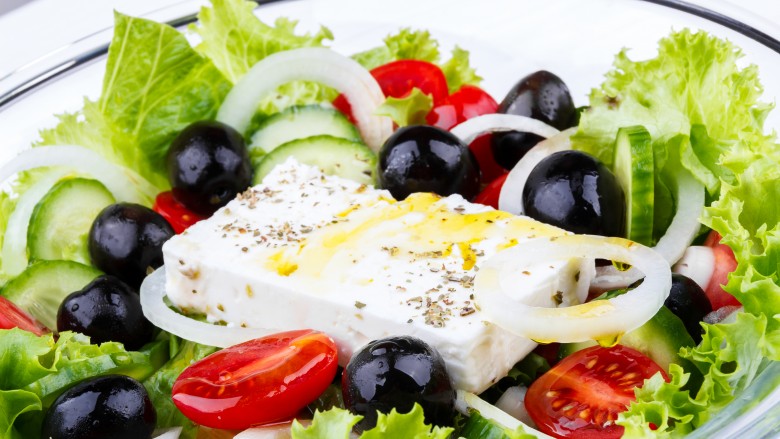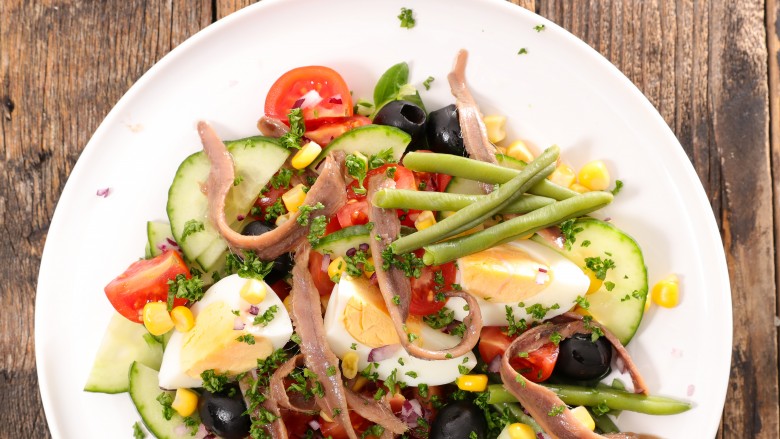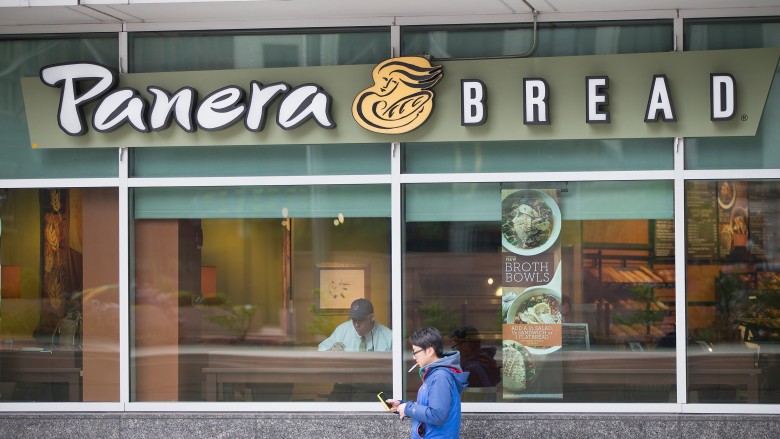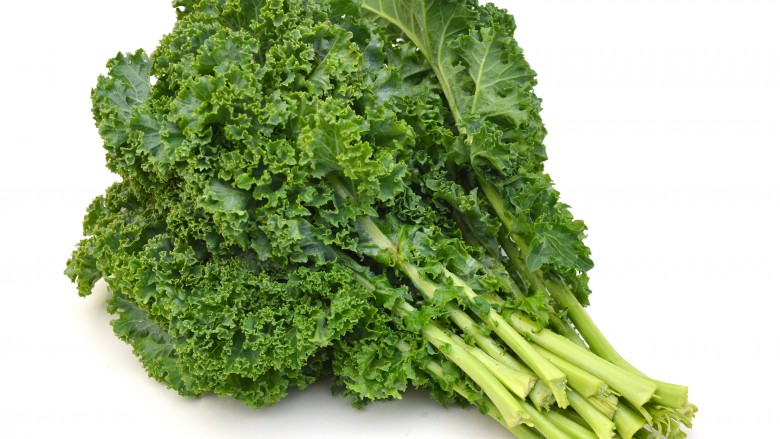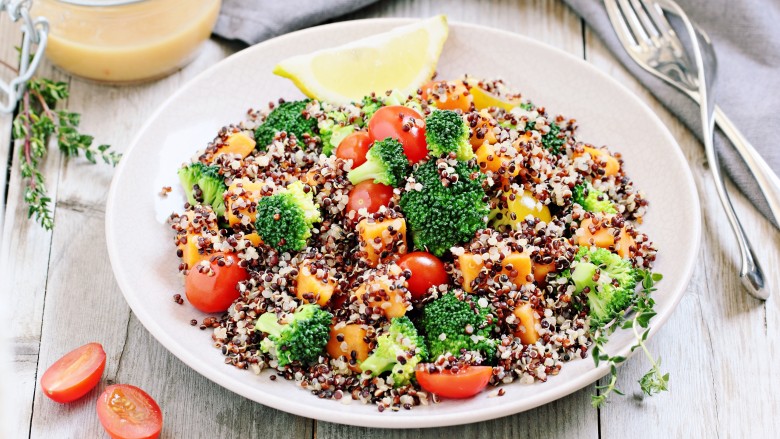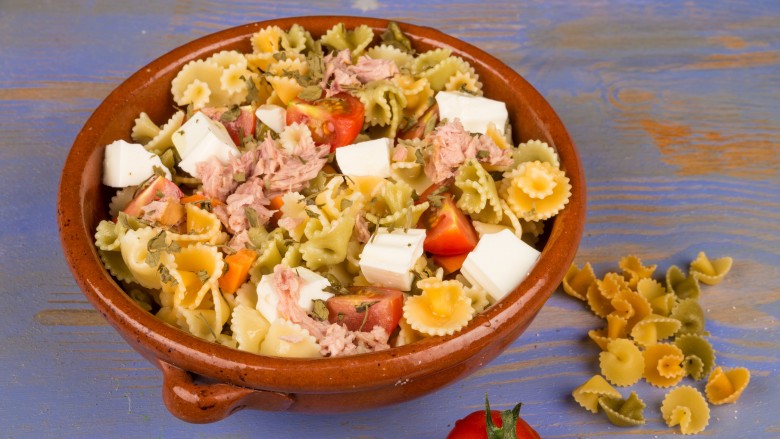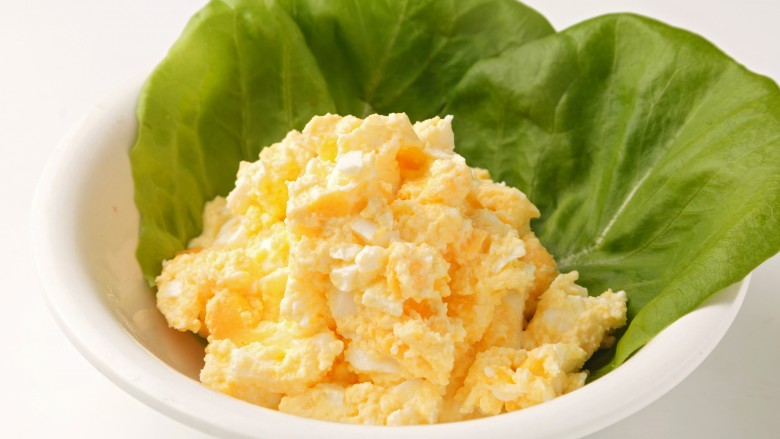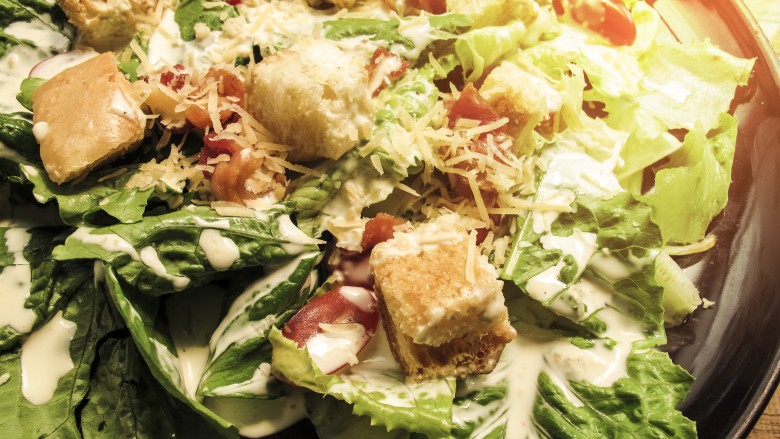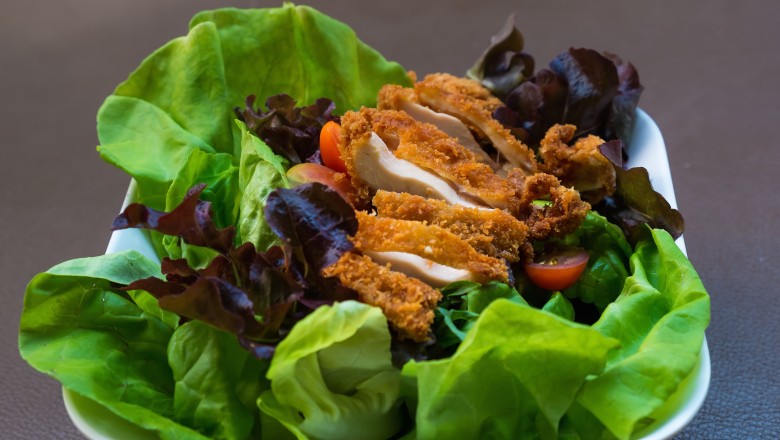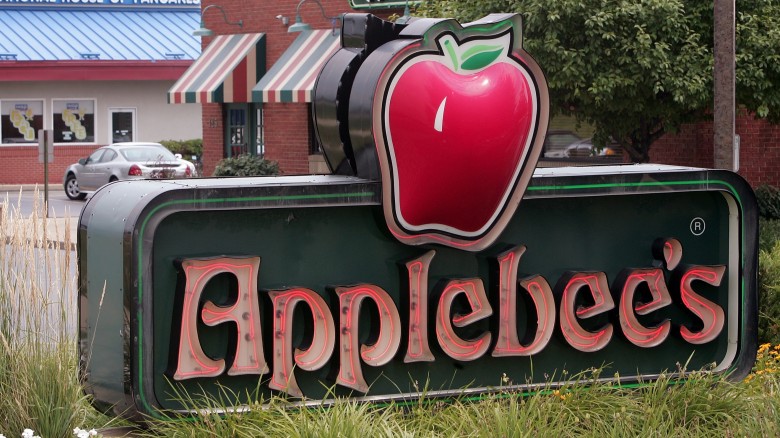5 Salads You Should Be Eating And 5 You Shouldn't
What makes a salad truly great? In order to answer that, it's helpful to consider what a salad is typically comprised of in the most basic sense: fresh produce, contrasting textures, a flavorful dressing, and sometimes, protein. Also implicit in the word 'salad' is the expectation of a healthful meal choice, high in fiber, low in sugar and bad fats. You can bend the rules depending on the dish — a fruit or potato salad, for example, is still a salad in the traditional sense of the word, though they're less vegetable-forward than a conventional green salad. Bearing all this in mind, coupled with the obvious fact that a salad should taste good, here are five salads you should be eating and five that you really shouldn't.
Do eat: Greek salad
You're late to the party if you've missed the newsflash that the Mediterranean diet is good for you. This puts the iconic Greek salad as a front-runner for good salad choices, both flavor- and health-wise. Greek salads feature cucumbers, tomatoes, red onions, and Kalamata olives, usually accompanied by feta cheese, oregano, and olive oil. So why is it so good for you? Registered dietitian Andy De Santis says, "The main strength of the Greek salad is its high monounsaturated fat content which comes from the olive oil and the olives themselves present in the salad. Monounsaturated fats are commonly referred to as 'healthy fats' because they have a positive impact on our blood cholesterol profile and, as a result, help protect our cardiovascular health... Just make sure you don't go too crazy with the salt and cheese!"
Do eat: nicoise salad
French in origin, the nicoise salad packs healthy fats and proteins along with fresh vegetables. In it you'll find tomatoes, anchovies, black olives, capers, French beans and lemon juice, with some potential variation depending on region. Dietitian Andy De Santis tells me, "The nicoise salad shares the benefits of the Greek salad when it comes to the olive oil and tomato component, but also brings the added benefit of containing both fish and eggs, which are great sources of protein (which will help keep you feeling full and satisfied) and two of the richest natural sources of vitamin D (which most people struggle to get enough of in their diets). An extra benefit of the nicoise salad is that the fish that is generally used (anchovies) is rich in omega-3 fatty acids, which provide additional protective cardiovascular benefits."
And not only is the nicoise salad healthy, but also it's easy to prepare on your own at home if you're on a budget. Registered dietitian Millie Shedorick says, "Nicoise salad can be quickly prepared at home by choosing canned tuna, anchovies and olives that are rich in healthy omega-3 fats, added to pre-washed dark, leafy greens and tomatoes with a hard-boiled egg and using a low fat vinaigrette will save calories."
Adaptable, affordable, and chock full of nutrients, the nicoise salad is among the best salad choices out there.
Do eat: Panera Green Goddess salad
Eating out at fast-food restaurants can be a challenge if you're trying to stay healthy. I've eaten my share of salads while traveling, and I was pleasantly surprised when I first had the Green Goddess salad from Panera. Dietitian Andy De Santis said, "Although one should always be wary about fast food salads, the Green Goddess salad has some serious power house greens in it including kale, romaine and arugula. Although I don't love the bacon, the avocado contains heart healthy monounsaturated fats as well as potassium, which most of us need more of... The protein from the egg and chicken turns this dish into a more satisfying and complete meal, without piling on the calories."
Dietitian Liz Blom adds, "All the ingredients are clean, meaning no artificial preservatives, sweeteners or flavors and no colors from artificial sources. A whole salad provides 530 calories, 31 grams of fat (7 saturated), and 35 grams of protein. I personally like the protein content of this salad and would find it to be more filling."
Do eat: kale salad
Fewer greens are more beloved by healthy eating experts than kale. And it's not surprising given its inherent, deep flavor and resilient, pleasing texture, rendering it perfect for salads. Dietitian Andy De Santis is no exception. "I love kale salad for a variety of reasons. First and foremost, it allows you to get a very powerful leafy green without much food prep time. Kale is high in a vitamin C (great for vegans to help increase iron absorption if salad is made with beans) and calcium, which is especially useful for people don't drink milk. It's also high in fiber and potassium which we all need more of, and also a variety of potent disease fighting compounds."
You can dress kale up with sliced grape tomatoes, toasted pine nuts, a little shaved Parmesan, and a balsamic reduction for a super healthy salad rich in flavor. Or you can toss it with sliced mangoes, toasted almonds, and lemon juice for a sweeter flavor. It's also common to serve chopped, raw kale with sliced strawberries, toasted walnuts, and chunks of ripe avocado and an orange vinaigrette. To top it off, kale is super affordable and comes in several different varieties, so happy eating!
Do eat: quinoa salad
Quinoa is one of the latest grains to become hip, thanks in part to its excellent nutritional profile. And it makes a mean salad base. Dietitian Liz Blom notes, "Quinoa salads might be one of my favorites based upon the texture and versatility of the grain itself. From a nutrient standpoint, adding quinoa to a salad provides fiber (5 grams per cup), so you're likely to eat less and stay satisfied longer. Quinoa is also gluten-free, high in protein and one of the few plant foods that contain all nine essential amino acids (which supports lean body mass). Things to take into consideration around quinoa salad would be the ingredients and dressings combined. It's likely if a salad contains quinoa it will have healthy components to compliment it like fresh vegetables, grapes, berries or dried fruit and a light citrus and oil based dressing that the quinoa will soak up."
So basically, you can boil up some quinoa in a stock, cool it, and toss it with vegetables and a bit of dressing. Boom, you've got a super flavorful, satiating, healthy salad that doubles as a meal or a side. Just don't douse it in a ton of fats and you're all set.
Don't eat: pasta salad
Pasta salad is tasty, no doubt about it. But its designation as a salad is a bit tenuous.
According to Liz Blom, "When a salad is lacking greens or vegetables of any form, I'm not sure it constitutes a true salad. Pasta salad mainly contains carbs and fat. If you are trying to choose healthy to side with your protein, choose salad with a side of pasta."
I note that you can make a reasonably healthy pasta salad if you add a lot of vegetables, a healthy dressing, and fresh herbs. But seldom does pasta get married into a low-calorie, high-nutrient situation as it's far to easy to toss it with ingredients that are also high in calories.
Don't eat: egg salad
I'm not sure how egg salad got it's name beyond tossing it with a lot of mayonnaise and a few, hopeful bits of green things like dill or celery. At best, you can tell yourself you're getting protein from the eggs, and that would be true. But that's not all you're getting. Dietitian Liz Blom notes, "An average deli egg salad sandwich can have more than 550 calories, 30 grams of fat and 445 milligrams of cholesterol. OUCH! The main ingredients include eggs and mayo. The biggest issues with these foods are cholesterol and saturated fat. Both can clog arteries and contribute to high-cholesterol levels when you've got too much in your diet."
You're better off sticking with boiled eggs, sliced and tossed with a conventional green salad.
Don't eat: Cheesecake Factory Caesar salad with chicken
The chicken Caesar salad is a prime example of how not all salads are as healthy as you might think. Dietitian Andy De Santis says, "Caesar salad is one of my least favorite [salads] due to the high caloric content of the added cheese and the dressing and the fact the primary veggie used is romaine lettuce, which is nutritionally unexceptional when compared to traditional powerhouses like kale, chard and spinach."
The Cheesecake Factory, admittedly, is notorious for some of its more high-calorie menu options. So it's not surprising that their salad offerings are no exception, notably the aforementioned chicken Caesar. So how bad could it be? In a nutshell, from dietitian Liz Blom, "For an average female you can enjoy your daily intake in one sitting at a mere 1,550 calories, 23 grams saturated fat and 1664 mg sodium. Need I say more?"
Don't eat: McDonald's Southwest buttermilk crispy chicken salad
Poor McDonald's. I'm not sure they've ever really hit the mark with their salad market in spite of years of trying. One of their more recent salad offerings piqued my interest, though: the Southwest buttermilk crispy chicken salad. Indeed, McDonald's has stepped up their game, as this salad features a variety of greens (including kale), fresh herbs, and Newman's Own dressing. And while it sounds good, dietitian Andy De Santis notes, "Sweet, buttermilk and crispy are the last three words you want to see in front of chicken when you are attempting to have a healthy meal." dietitian Liz Blom added, "This salad weighs in at 510 calories, with 44 percent of those calories coming from fat and 30 percent of the daily value coming from saturated fat. It's also very salty!"
So it looks like McDonald's didn't make it work with this one either given the nutritional profile. For 30 more calories, just order the Big Mac and be done with it.
Don't eat: Applebee's Oriental grilled chicken salad
I asked one of the dietitians that I spoke to, Liz Blom, to pick one of her least favorite salads, restaurant or conventional. She said, "Our best intentions can bite us in the behind. Take for example, Applebee's Oriental Chicken Salad. You definitely won't be eatin' good in the neighborhood if you order this beauty of a salad even with grilled chicken versus fried. It sounds healthy enough, but this plate of Asian greens, tossed in a tasty oriental vinaigrette and topped with crispy noodles, toasted almonds, and grilled chicken has 1,290 calories, 85 grams of fat, and more than a day's worth of sodium, plus 13 teaspoons of sugar. In fact, the sodium increases by 700 mg when you forgo the fried chicken. You might as well order the fries and the malt and call it a day."

